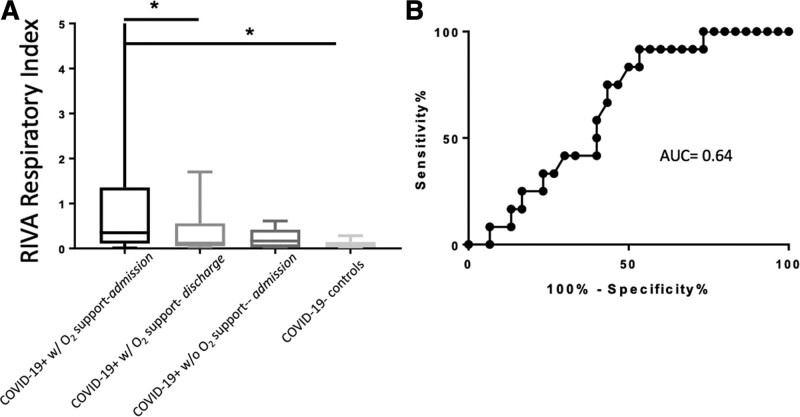Figure 5.
Respiratory non-invasive venous waveform analysis respiratory index (RIVA-RI) for coronavirus disease 2019–positive (COVID-19+) patients and coronavirus disease 2019–negative (COVID-19–) controls (A) and area under the curve (AUC) for predicting oxygen requirement (B). The amplitude of the respiratory signal relative to the amplitude of the cardiac signal was derived from the venous waveforms after fast Fourier transformation, and this ratio represents the RIVA-RI (A). The RIVA-RI for COVID-19+ patients admitted to the hospital and requiring oxygen support during hospitalization (median = 0.27, n = 34) was significantly higher (p < 0.01; 95% CI, 0.4008–2.037) than the RIVA-RI for COVID-19– controls (median = 0.06; n = 34). The RIVA-RI for COVID-19+ patients who required oxygen support was also significantly higher (p = 0.02; 95% CI, 0.1023–1.939) than the RIVA-RI for those same patients at time of discharge (median = 0.12; n = 24). The RIVA-RI was not significantly different (p = 0.09; 95% CI, –0.1242 to 2.265) for COVID-19+ patients who required oxygen support during hospitalization and those COVID-19+ patients who never required oxygen support during hospitalization (median = 0.2; n = 11). Statistical analysis was completed using analysis of variance with multiple comparisons between groups. Horizontal bars with star (*) demonstrate statistical significance. The ability of the RIVA-RI for predicting the need for oxygen support (B) during admission for COVID-19+ patients demonstrated an AUC of 0.64 (95% CI, 0.48–0.81). At a RIVA-RI value of greater than or equal to 0.6 had a 92% sensitivity (95% CI, 61.52–99.79%) and 47% specificity (95% CI, 28.34–65.67%) for predicting need for oxygen support during admission for COVID-19+ patients.

